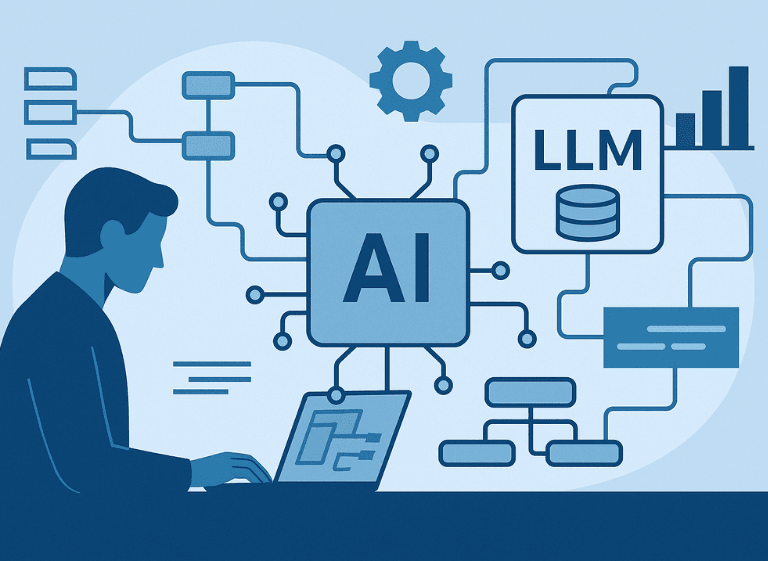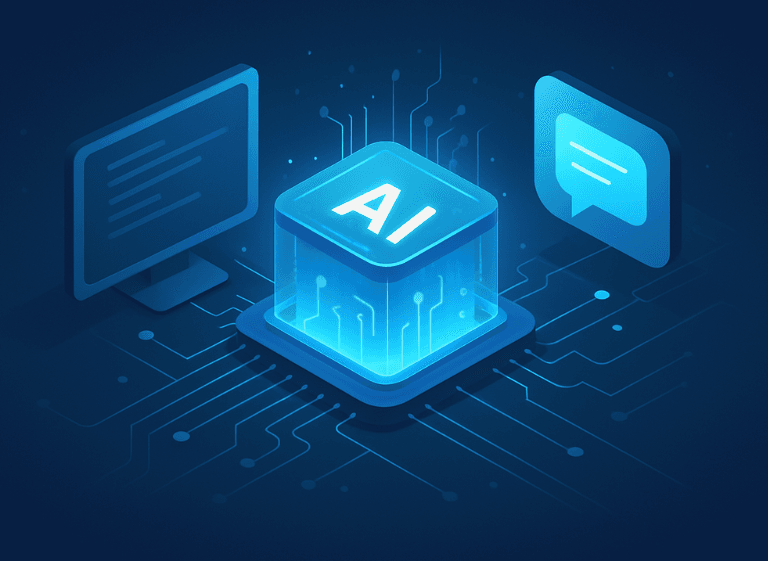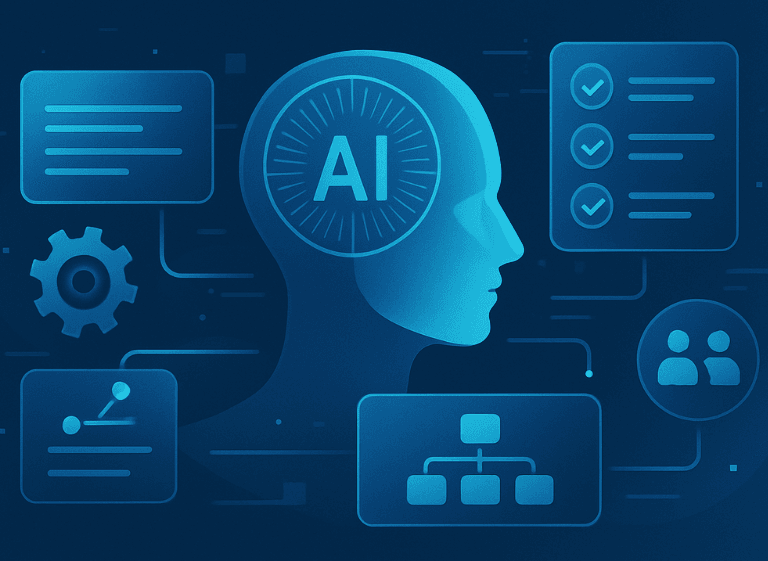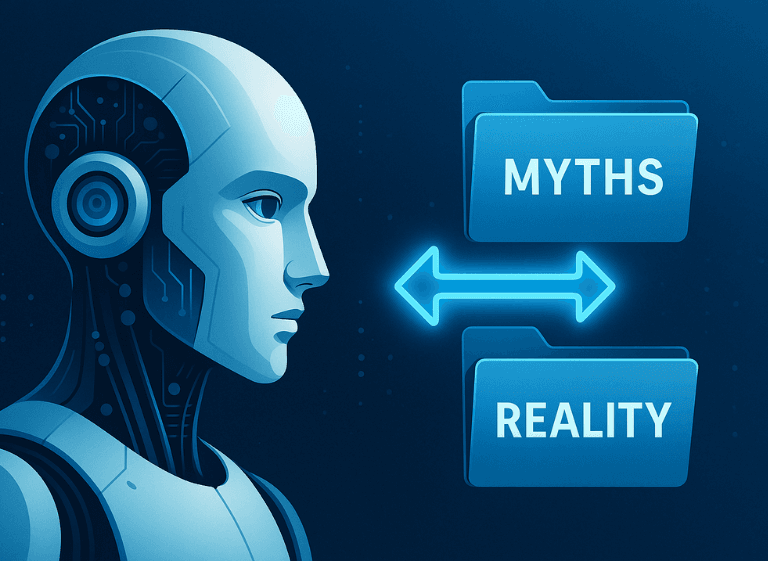AI tools
Software development
Real project examples
Product strategy
DevOps practices
Security practices
How AI and LLMs Are Transforming Custom B2B Workflows
Nadiia Sidenko
2025-07-17
What if your biggest workflow bottleneck wasn't your team's capacity, but the very tools you trusted to streamline operations? While most B2B companies chase the latest SaaS solution, forward-thinking organizations are discovering that ai workflow automation and custom b2b workflow solutions aren't just buzzwords—they're the competitive differentiators that separate market leaders from followers. In this deep dive, you'll discover why generic platforms fail at scale, how large language models are revolutionizing enterprise operations, and the practical steps to implement AI-powered workflows that actually deliver measurable ROI.

Why Generic SaaS Fails at Scale in B2B Environments
The promise of plug-and-play business software has seduced countless B2B organizations into believing that one-size-fits-all solutions can handle their unique operational complexity. Yet the reality paints a different picture. As companies scale beyond the startup phase, they discover that custom software for b2b operations becomes not just beneficial, but essential for maintaining competitive advantage.
The fundamental issue lies in the architectural limitations of generic SaaS platforms. These tools are designed for the broadest possible market appeal, which means they excel at handling common use cases but struggle with the nuanced requirements that define successful B2B operations. When your sales cycle spans multiple quarters, involves complex approval hierarchies, and requires integration with legacy systems, generic solutions become constraining rather than enabling.
Workflow process automation through standard platforms often creates more friction than it removes. Teams find themselves adapting their proven processes to fit software limitations rather than optimizing workflows for maximum efficiency. This backwards approach to business optimization explains why many organizations experience diminishing returns from their SaaS investments as they grow.
When Plug-and-Play Becomes Plug-and-Pray
The seductive simplicity of off-the-shelf workflow tools masks a darker reality: workflow inefficiencies in teams compound exponentially as organizations scale. What begins as minor workarounds in a 10-person company becomes systemic dysfunction in a 100-person enterprise.
Consider the typical evolution: a growing B2B company adopts a popular project management platform that handles basic task assignment and deadline tracking. Initially, the tool feels transformative. But as the company expands, they discover the platform can't handle their specific client onboarding process, doesn't integrate with their custom CRM, and forces fragmented business communication across multiple disconnected systems.
Teams begin developing elaborate workarounds—spreadsheets that shadow the "official" system, email chains that bypass the platform entirely, and manual processes that defeat the automation's purpose. The result isn't improved efficiency; it's operational chaos disguised as digital transformation.
For companies facing these challenges, understanding when SaaS platforms fall short becomes crucial for making informed decisions about workflow optimization.
Signs You've Outgrown Standard Workflow Tools
Recognizing when your business process workflow has outgrown generic solutions requires honest assessment of your operational reality. The warning signs often appear gradually, making them easy to dismiss as temporary growing pains rather than fundamental systemic issues.
Workflow automation for companies should reduce manual intervention, not create new categories of administrative overhead. If your team spends significant time managing the tools meant to help them, you've likely crossed the threshold where custom solutions become cost-effective.
Here are the key indicators that your organization needs workflow automation services tailored to your specific requirements:
- Data silos multiplication: When teams maintain separate systems for similar functions because the central platform can't accommodate their specific needs
- Integration complexity explosion: Adding new tools requires extensive workarounds because your current stack doesn't support seamless connectivity
- Process compliance gaps: Standard platforms can't enforce your industry-specific or internally developed best practices
- Scalability bottlenecks: Performance degrades or costs increase disproportionately as your team or data volume grows
- Customization limitations: You find yourself saying "if only this tool could..." more frequently than "this tool helps us..."
| Warning Sign | Generic SaaS Response | Custom Solution Capability |
|---|---|---|
| Complex approval workflows | Basic yes/no routing | Multi-conditional logic with role-based permissions |
| Industry-specific compliance | Generic audit trails | Tailored compliance frameworks and reporting |
| Legacy system integration | Limited API connections | Purpose-built connectors and data transformation |
| Unique business logic | Workarounds and manual processes | Native automation of proprietary workflows |
AI and LLMs for Business Workflow Automation

The emergence of ai workflow automation represents more than incremental improvement—it's a fundamental shift in how B2B organizations can approach operational efficiency. Unlike traditional automation that requires explicit programming for every scenario, AI-powered systems can adapt to context, learn from patterns, and handle the ambiguity that characterizes real-world business processes.
Business automation workflow powered by artificial intelligence doesn't just execute predefined sequences; it makes intelligent decisions based on data patterns, contextual understanding, and learned behaviors. This capability transforms workflows from rigid instruction sets into adaptive systems that improve over time.
The distinction matters because B2B operations rarely follow perfectly predictable patterns. Client requests vary in complexity, market conditions shift priorities, and team dynamics evolve. Traditional automation breaks down when faced with these variables, but AI-powered systems can interpret intent, classify requests appropriately, and route tasks to the most suitable resources.
From Request Classification to Entity Extraction
Large language models in business excel at understanding unstructured data—the emails, documents, and communications that drive most B2B workflows. Unlike traditional systems that require structured inputs, LLMs can process natural language requests and extract actionable information without rigid formatting requirements.
Request classification becomes particularly powerful when applied to customer service, sales inquiries, and internal communications. Instead of forcing clients to navigate complex forms or select from predefined categories, LLM in enterprise software can analyze free-form requests and automatically route them to appropriate departments with relevant context intact.
Entity extraction takes this concept further by identifying specific data points within unstructured communications. An email about a contract renewal might contain the client name, contract value, renewal date, and special requirements. LLMs can extract these entities automatically, populate relevant systems, and trigger appropriate workflows without human intervention.
Organizations exploring ai-powered business workflows discover that this capability extends beyond simple automation to genuine intelligence augmentation. Teams can focus on high-value activities while AI handles the cognitive overhead of information processing and task routing.
The practical applications extend to document processing, where automating internal business processes through AI can transform how organizations handle contracts, proposals, and compliance documentation.
AI-Powered Email Summarization and Workflow Memory Optimization
Email remains the backbone of B2B communication, yet it's also the source of significant workflow inefficiency. Chatgpt for workflow management addresses this challenge by providing intelligent email processing that goes beyond simple filtering to deliver contextual understanding and actionable summaries.
AI-powered email summarization doesn't just extract key points; it maintains context across conversation threads, identifies action items, and suggests appropriate responses based on historical patterns. This capability becomes invaluable for teams managing multiple client relationships or complex project communications.
Workflow memory optimization represents another frontier where ai for business workflows delivers tangible value. Traditional systems treat each interaction as isolated events, but AI-powered workflows can maintain contextual memory across interactions, learning from past decisions to improve future performance.
Advanced email processing tools like Docsbot Email Summarizer and Taskade GPT Email Agent demonstrate how AI can transform email from a productivity drain into a strategic workflow enabler.
The memory optimization aspect extends to project management, where AI can track decisions, remember preferences, and suggest optimizations based on historical performance data. This creates workflows that genuinely improve over time rather than simply executing the same processes repeatedly.
How to Integrate AI and LLMs into Business Workflow Automation

Successful workflow automation process integration requires strategic planning rather than ad-hoc implementation. Organizations that achieve meaningful results from AI adoption follow structured approaches that prioritize practical value over technological novelty.
The integration process begins with identifying workflows that combine high volume, clear patterns, and measurable outcomes. These characteristics ensure that AI implementation delivers quantifiable benefits while providing sufficient data for system learning and optimization.
Openai business integration serves as a practical starting point for most organizations because it provides robust capabilities through well-documented APIs. However, successful integration requires more than technical implementation—it demands careful consideration of data privacy, user experience, and organizational change management.
API Integration, Customization, and Privacy
Enterprise ai integration benefits become most apparent when organizations approach API integration with clear architectural principles. Rather than bolting AI capabilities onto existing systems, successful implementations design workflows that leverage AI's strengths while maintaining system reliability and data security.
The technical foundation requires robust API management that handles authentication, rate limiting, and error handling gracefully. Gpt workflow automation involves asynchronous processing, contextual state management, and careful prompt engineering to ensure consistent, reliable results.
Privacy considerations become paramount when integrating AI into business workflows. Organizations must implement data handling procedures that protect sensitive information while enabling AI systems to provide valuable insights. This often involves techniques like data anonymization, secure processing environments, and audit trails that demonstrate compliance with privacy regulations.
For technical teams beginning this journey, resources like How to Integrate OpenAI API and Integrating OpenAI API provide practical guidance for handling software integration challenges.
| Integration Aspect | Key Considerations | Best Practices |
|---|---|---|
| API Security | Authentication, rate limiting, data encryption | Implement OAuth 2.0, monitor usage patterns, encrypt sensitive data |
| Error Handling | Graceful degradation, fallback mechanisms | Design workflows that function even when AI services are unavailable |
| Cost Management | Token usage optimization, request batching | Monitor API costs, implement caching strategies, optimize prompt efficiency |
| Performance | Response time optimization, scaling strategies | Use asynchronous processing, implement connection pooling, cache frequent requests |
When and Why You Should Build Custom LLM Solutions
Custom llm business solutions become necessary when organizations require capabilities that extend beyond general-purpose AI services. The decision to build custom solutions depends on factors including data sensitivity, specialized domain knowledge, and integration complexity.
The tipping point often occurs when organizations realize that their competitive advantage depends on proprietary workflows that can't be replicated through generic AI services. Llm in b2b saas replacement makes sense when existing platforms constrain rather than enable business differentiation.
Custom LLM development allows organizations to train models on their specific data, implement domain-specific logic, and create workflows that reflect their unique business processes. This approach provides maximum flexibility but requires significant technical expertise and ongoing maintenance.
Organizations considering custom development should explore resources like Automating Business Workflows with Custom GPTs to understand the strategic implications and implementation challenges.
The decision framework should consider not just technical feasibility but also organizational readiness, maintenance requirements, and long-term strategic alignment. Custom solutions provide maximum flexibility but require ongoing investment in development and operations.
Business Benefits of AI-Powered Workflow Automation

Business process automation workflow delivers measurable value when implemented strategically, but the benefits extend beyond simple efficiency gains to encompass competitive differentiation and organizational capability building.
The primary advantage lies in automating complex workflows that previously required significant human intervention. AI-powered systems can handle nuanced decision-making, adapt to changing conditions, and maintain consistency across large volumes of transactions.
Organizations that successfully implement AI workflow automation report improvements in processing speed, error reduction, and team satisfaction. More importantly, they free human resources to focus on strategic activities that directly impact business growth and client relationships.
Productivity Gains Through Custom Development
Improve team productivity through AI implementation requires focusing on workflows where automation provides the greatest leverage. The most successful implementations identify bottlenecks that constrain team performance and design custom solutions that eliminate these friction points.
Custom development enables organizations to boost team productivity by creating workflows that match their specific operational patterns rather than forcing teams to adapt to generic software limitations. This alignment between process and technology creates exponential productivity gains that compound over time.
The productivity through custom development approach demonstrates how tailored solutions can address unique organizational challenges that generic platforms cannot accommodate. For instance, MindRecorder—a cross-platform productivity solution developed for visual communication and workflow optimization—integrated AI capabilities to automate routine documentation tasks and enhance team collaboration through intelligent screen capture and content organization. This custom approach to workflow automation enabled distributed teams to reduce communication delays and accelerate decision-making processes significantly. When teams can work within systems designed specifically for their needs, productivity improvements often exceed initial projections.
Key productivity metrics to track include:
- Process completion time: Measure end-to-end workflow duration before and after AI implementation
- Error reduction rates: Track accuracy improvements in data processing and decision-making
- Resource allocation efficiency: Monitor how AI automation affects team capacity and focus
- Client satisfaction scores: Assess how workflow improvements impact external relationships
Marketplace Tools That Extend AI Capabilities
B2b process automation tools available through specialized marketplaces provide organizations with pre-built solutions that can be customized for specific needs. These tools bridge the gap between generic SaaS platforms and fully custom development.
Workflow automation vendors offer specialized modules that address common B2B challenges while providing integration capabilities that support broader automation strategies. Organizations can leverage these tools to accelerate implementation while maintaining flexibility for future customization.
The scalable workflow automation for teams approach through marketplace solutions allows organizations to implement AI capabilities without extensive custom development. Pinta Shop offers over 100 CMS plugins for eCommerce platforms including CS-Cart, PrestaShop, OpenCart, and WordPress, featuring AI filters, SEO tools, and UX improvements that demonstrate how specialized modules can enhance business operations. Tools like ChatGPT 4 for OpenCart: Automated SEO Content Solution and Translate AI for OpenCart demonstrate how specialized AI modules can address specific business functions.
This marketplace approach provides several advantages:
- Reduced development time: Pre-built solutions accelerate implementation
- Lower technical risk: Proven modules reduce implementation uncertainty
- Flexible scaling: Organizations can add capabilities as needs evolve
- Cost efficiency: Shared development costs make advanced features accessible
B2B AI Integration: Myths vs Reality

Ai for business workflows adoption is often hindered by misconceptions that create unnecessary resistance to implementation. Understanding the reality behind common myths enables organizations to make informed decisions about AI integration.
The gap between AI expectations and reality stems from oversimplified marketing messages that promise revolutionary transformation without acknowledging implementation complexities. Saas limitations for b2b become particularly apparent when organizations discover that AI integration requires significant planning, customization, and ongoing optimization.
Realistic AI deployment involves iterative improvement rather than immediate transformation. Organizations that succeed with AI integration focus on specific use cases, measure results carefully, and scale gradually based on proven value.
"AI Will Replace Everyone" — and Other Misconceptions
Ai myths about job displacement create organizational resistance that can prevent beneficial implementations. The reality is that AI augments human capabilities rather than replacing them, particularly in B2B environments where relationship management and strategic thinking remain fundamentally human activities.
Enterprise ai integration benefits emerge most clearly when AI handles routine cognitive tasks while humans focus on complex problem-solving, relationship building, and strategic decision-making. This division of labor creates more engaging work environments rather than replacing human workers.
Common misconceptions include beliefs that AI implementation requires massive technical overhauls, that AI systems work perfectly without human oversight, and that successful AI deployment guarantees immediate ROI. Resources like Common AI Myths and AI Myths Debunked provide evidence-based perspectives on realistic AI capabilities.
The most persistent myth involves the belief that AI systems learn independently and improve automatically. In reality, AI systems require ongoing training, monitoring, and optimization to maintain performance and adapt to changing business conditions.
What Realistic AI Deployment Looks Like
Software integration challenges in AI deployment often stem from unrealistic expectations about implementation timelines and complexity. Successful AI integration requires careful planning, incremental rollouts, and continuous optimization based on real-world performance data.
Integration issues in business software become particularly complex when organizations attempt to implement AI across multiple systems simultaneously. The most successful approaches focus on specific workflows, prove value through pilot programs, and scale gradually based on demonstrated results.
Realistic AI deployment involves accepting that initial implementations will require refinement, that user training is essential for adoption, and that ongoing maintenance is necessary for sustained value.
Organizations that approach AI integration with these expectations achieve better results than those expecting immediate transformation.
For organizations considering AI integration, understanding the benefits of custom workflow development and professional AI development services provides realistic frameworks for implementation planning.

Conclusion
When Custom Workflow Automation Becomes a Competitive Advantage
Workflow management startups and established enterprises alike discover that workflow and process automation becomes a competitive differentiator when implemented strategically rather than tactically. The organizations that gain sustainable advantages treat AI-powered workflow automation as a core business capability rather than a supplementary tool.
The transformation from operational necessity to competitive advantage occurs when custom workflow automation enables capabilities that competitors cannot easily replicate. This differentiation emerges through deep integration of AI capabilities with proprietary business processes, creating workflows that become increasingly effective over time.
Key Evaluation Questions for B2B Teams
Custom b2b workflow solutions merit serious consideration when organizations can answer "yes" to several critical evaluation questions. Workflow automation services become strategic investments rather than operational expenses when they address fundamental business constraints.
Consider these evaluation criteria:
- Does your current workflow software limit your ability to serve clients effectively?
- Are your teams spending more time managing tools than completing productive work?
- Do your operational processes provide competitive differentiation that generic software cannot support?
- Are solving communication bottlenecks and workflow inefficiencies preventing your organization from scaling?
- Would custom automation enable your team to focus on high-value activities that drive business growth?
Organizations that identify clear positive responses to these questions should explore workflow automation tools that can address their specific challenges.
The decision to invest in custom workflow automation represents a strategic choice about competitive positioning. Organizations that implement AI-powered custom workflows effectively create operational advantages that compound over time, making them increasingly difficult for competitors to replicate.
Ready to transform your B2B workflows with AI-powered automation? Explore our AI development services to discover how custom solutions can address your specific operational challenges and drive sustainable competitive advantage.